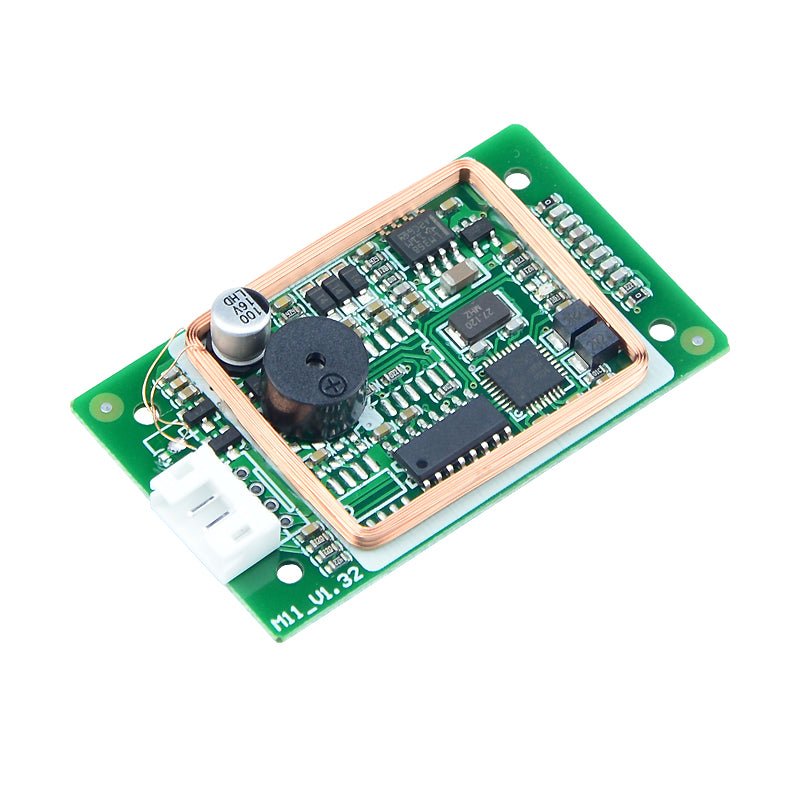
10pcs M11 Dual-Frequency RFID Reader Modules
Description:
M11 RFID reader modules adopts 13.56MHZ monolithic composite microprocessing technology, which effectively improves the stability of CPU operation and has the ability to automatically reset to prevent jamming.
THE MODULE HAS THE ABILITY TO READ 125KHZ LOW-FREQUENCY ID CARD AND 13.56MHZ
The high-frequency ISO14443-A protocol IC card supports a variety of communication interface options and has a complete set of serial communication protocol instructions.
Technical parameters
Communication interface: USB communication, Uatr TTL communication, RS232 communication, RS485 communication, Wiegand communication;
Card reading distance: ID card 3-4cm IC card 3-5cm;
Card reading time: 1S;
Protocol standards: uEM, IEC/ISO 14443A;
Supported card types: ISO 14443 Type A Mifare standard contactless card types and TK/EM series low-frequency cards;
Card reading method: active card reading and passive card reading;
Card number format: support tool settings or protocol settings;
Operating Voltage: DC5V±5%;
Operating system: windowsXP, 7, 8, 10, Linux, Android, MCU;
Working environment: Temperature: -10°C~50°C; Relative humidity: 5%~93% (non-condensing);
Storage Environment: Temperature: -20°C~60°C; Relative humidity: 5%~95% (non-condensing);
Status Reminder: LED indicator, controllable buzzer;
Product size: 50mm×30mm;
Other features: Provide serial communication protocol instructions, support Android system and single-chip microcomputer development;

10pcs M11 Dual-Frequency RFID Reader Modules
If you have any questions, you are always welcome to contact us. We'll get back to you as soon as possible, within 24 hours on weekdays.
-
Shipping Information
Use this text to answer questions in as much detail as possible for your customers.
-
Customer Support
Use this text to answer questions in as much detail as possible for your customers.
-
FAQ’s
Use this text to answer questions in as much detail as possible for your customers.
-
Contact Us
Use this text to answer questions in as much detail as possible for your customers.
FAQs
Please read our FAQs page to find out more.
What transportation method do you use?
All our products are shipped via international express services, such as DHL and FedEx,? completely free of charge
What is DLP 3D printing, and how does it work?
DLP 3D printing is a resin-based additive manufacturing technology that uses light to cure liquid photopolymer layer by layer. It involves projecting digital images onto a vat of liquid resin, where the exposed resin hardens to form each layer of the 3D object.
How does DLP 3D printing differ from other 3D printing technologies?
DLP 3D printing differs from other technologies such as FDM (Fused Deposition Modeling) in its use of light to cure resin, which allows for faster and more precise printing. It also typically offers higher resolution and smoother surface finishes.
Why are UV projectors critical in DLP 3D printing?
UV projectors are critical in DLP 3D printing because they emit the ultraviolet light that cures the resin. The quality, speed, and reliability of the printing process depend heavily on the performance of the UV projector.
What factors should be considered when selecting a UV projector for DLP 3D printing?
When selecting a UV projector, factors to consider include wavelength, resolution, LED lifespan, controller compatibility, and mechanical integration. The ideal projector should match the specific needs and requirements of the DLP 3D printing system.
What are the system requirements for DLP 3D printing?
System requirements for DLP 3D printing include a compatible UV projector, resin vat, build platform, and control system. Specific hardware specifications, such as resolution and interface compatibility, should also be considered.
How do I connect and configure a DLP 3D printing system?
Connecting and configuring a DLP 3D printing system typically involves connecting the UV projector to a PC via USB, launching the manufacturer's proprietary configuration software, and setting up the printer parameters, such as layer thickness and exposure time.
What is "pixelation" in DLP 3D printed models, and how can it be addressed?
Pixelation" refers to the appearance of tiny square or grid-like patterns on the surface of DLP 3D printed models. It can be addressed by increasing the resolution of the UV projector, adjusting the light curing parameters, or optimizing the print path.
What role do TIR prisms play in DLP 3D printing, and why are they important?
TIR (Total Internal Reflection) prisms play a critical role in DLP 3D printing by precisely redirecting light from the micro-mirror arrays to the projection optics. They maintain polarization and ensure that the light is evenly distributed across the resin vat, which is essential for high-quality printing.
What languages and currencies are supported on
The website supports multiple languages, including English, Simplified Chinese, Arabic, Korean, German, and Japanese. It also offers a variety of currency options, such as USD, EUR, AUD, and more, to cater to international visitors.
How can I stay updated with new collections and exclusive offers
To stay updated with new collections and exclusive offers, you can subscribe to the website's newsletter by providing your email address. This will allow you to receive notifications about the latest products, promotions, and news directly to your inbox.
